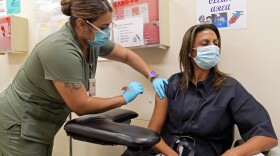Economically disadvantaged neighborhoods on Austin’s East Side experienced significantly higher infection rates of COVID-19, according to a new study from experts at UT Austin.
While national data on COVID-19 infections and vaccination rates have long suggested that the virus affected low-income and minority groups at higher rates, this new research offers a hyperlocal view of pandemic disparities over a long-term period in Austin.
“[Prior studies] weren't comparing neighborhoods in the same city. They were comparing counties in a state or states to each other,” said Lauren Ancel Meyers, the director of UT’s Center for Pandemic Decision Science and an author of the study. “What we find here is that those same disparities play out at a very local scale at the level of ZIP codes and at the level of neighborhoods.”
Meyers and her colleagues studied Travis County hospitalization rates and public health data from the first 15 months of the pandemic and determined the number of individuals who were likely infected in each ZIP code. They found that people in the most impoverished areas with the most essential workers were about 2.5 times more likely to be infected with COVID than residents in wealthier areas. These ZIP codes were concentrated on the east side of I-35.

The study did not account for any potential re-infections, since they were uncommon before the emergence of the Delta variant, which came after the time period reviewed by researchers.
The highest infection rate was in the 78724 ZIP code, home to the Colony Park and Las Cimas neighborhoods; researchers estimate that 53.7% of residents in this ZIP code contracted COVID-19 during the study period. The 78732 ZIP code in West Austin, which is home to the Steiner Ranch neighborhood, had the lowest infection rate at 4.8%.
The disparities were largest in the earliest months of the pandemic, when residents of vulnerable neighborhoods were closer to 10 times more likely to be infected. The gap narrowed over the course of the study period as local officials began to focus more outreach on the East Side, but it never closed.
This persistent gap, Meyers said, should serve as a “call to action” for local leaders heading into future public health emergencies.
“As we continue to understand what's causing those disparities, we try to remedy them now,” she said. “We don't wait until the next pandemic to try to target resources on the fly.”
Meyers suggests solutions such as improving public health communication to vulnerable neighborhoods, shoring up access to basic health infrastructure, and building out protections for essential workers who cannot afford to miss work.
Additionally, Meyers says ensuring vulnerable neighborhoods have adequate education about and access to testing is an important piece of the puzzle. While lower-income neighborhoods were more likely to contract COVID-19, they were also around 30% less likely to have that infection tested and reported through official public health channels.
“If a public health system doesn't know that a community is facing high rates of infection … then it doesn't know that community needs additional resources,” she said.













